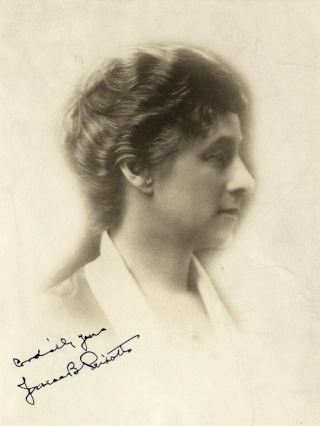
The Bear Flag is the official flag of the U.S. state of California. The precursor of the flag was first flown during the 1846 Bear Flag Revolt and was also known as the Bear Flag. A predecessor, called the Lone Star Flag, was used in an 1836 independence movement; the red star element from that flag appears in the Bear Flag of today.

William Henry Crocker I was a member of the wealthy Crocker family and a prominent member of the Republican Party. Over the course of his business career, he became the president of Crocker National Bank.

Milicent Washburn Shinn was a writer, editor, and child psychologist. She was the first woman to receive a doctorate from the University of California, Berkeley. She entered the State University in September 1874 and finished her undergraduate degree in 1880. She was one of three student speakers at the commencement. She edited the Overland Monthly from 1882 to 1894. She received her Ph.D. in 1898 at the age of 40.
The Western Pacific Railroad (1862–1870) was formed in 1862 to build a railroad from Sacramento, California, to the San Francisco Bay, the westernmost portion of the First transcontinental railroad. After the completion of the railroad from Sacramento to Alameda Terminal on September 6, 1869, and then the Oakland Pier on November 8, 1869, which was the Pacific coast terminus of the transcontinental railroad, the Western Pacific Railroad was absorbed in 1870 into the Central Pacific Railroad.

The College Equal Suffrage League (CESL) was an American woman suffrage organization founded in 1900 by Maud Wood Park and Inez Haynes Irwin, as a way to attract younger Americans to the women's rights movement. The League spurred the creation of college branches around the country and influenced the actions of other prominent groups such as National American Woman Suffrage Association (NAWSA).

Laura de Force Gordon was a California lawyer, newspaper publisher, and a prominent suffragette. She was the first woman to run a daily newspaper in the United States, and the second female lawyer admitted to practice in California.

The California Nursery Company was established in Niles, California, and incorporated in 1884 by John Rock, R. D. Fox, and others. The nursery sold fruit trees, nut trees, ornamental shrubs and trees, and roses. It was responsible for introducing new hybrids created by such important West Coast breeders as Luther Burbank and Albert Etter.

Jessica Blanche Peixotto was an American educator and writer.

Mary Lynde Craig was an American writer, teacher, and attorney. She moved to California in 1859. She owned property in San Francisco, and was an activist for women's property rights. Craig served as Associate Editor of the Redlands, California The Citrograph. In 1893, she was one of four women practicing law in California. In 1891, she gave the "Address of Weicome" at the organization of Sequoia Chapter, San Francisco. While attending the National Editorial Association at Chicago with her husband, in May 1893, she also had opportunity to speak to other large audiences—once at the Auditorium, once at the Art Palace, and once at the Woman's Building. She served as president of the Pacific Coast Women's Press Association and historian of the Hastings Law column.

Helen Hoy Greeley was an American suffragist, lawyer, and political activist.
Snell Seminary School for Women was a girls school in Oakland and then Berkeley, California.
This timeline provides an overview of the political movement for women's suffrage in California. Women's suffrage became legal with the passage of Proposition 4 in 1911 yet not all women were enfranchised as a result of this legislation.

The women's suffrage movement began in California in the 19th century and was successful with the passage of Proposition 4 on October 10, 1911. Many of the women and men involved in this movement remained politically active in the national suffrage movement with organizations such as the National American Women's Suffrage Association and the National Woman's Party.
Selina Solomons (1862–1942) was a California suffragist active in the 1911 campaign which resulted in the passage of Proposition 4. Solomons wrote a first hand account of the movement titled, "How We Won the Vote in California".

María Guadalupe Evangelina de López (1881-1977) was an American activist in the Women's suffrage movement in California. In the 1910s, she campaigned and translated at rallies in Southern California, where suffragists distributed tens of thousands of pamphlets in Spanish.

Minora Ellis Kibbe was a social reformer and suffragist from California. She ran for a seat on the San Francisco area school board in 1908, and for California's 36th State Assembly district in 1918.

The California Equal Suffrage Association (CESA) was a political organization in the state of California with the intended goal of passing women's suffrage.

Ethel Sperry Crocker (1861–1934) was an American philanthropist and art patron. In her day, she was the leading patron of French Impressionism in California.















